
About the Early Warning System
Cambodia is a country consistently ranked as one of the most vulnerable to the effects of natural disasters.
In order to deliver timely and potentially lifesaving information to people in disaster prone areas, an Early Warning System (EWS) was conceived by the organization, People In Need (PIN) .
People in Need realized that the EWS needs to be accessible to all Cambodians, regardless of literacy and Internet connectivity issues. They decided to look into a solution which uses voice based messaging for alerts and Interactive Voice Response (IVR) for registration.
With help from the Royal Cambodian Government, the Telecommunication Regulator of Cambodia (TRC) and the National Committee for Disaster Management (NCDM), it was regulated that the Early Warning System must be provided free of charge by the Mobile Network Operators (MNOs) in Cambodia.
With the pieces of the puzzle coming together the problems that still remained were:
The major mobile network operators in Cambodia each provided a SIP connection, but lacked the technology that People In Need required to handle user registrations and send out automated flood alerts.
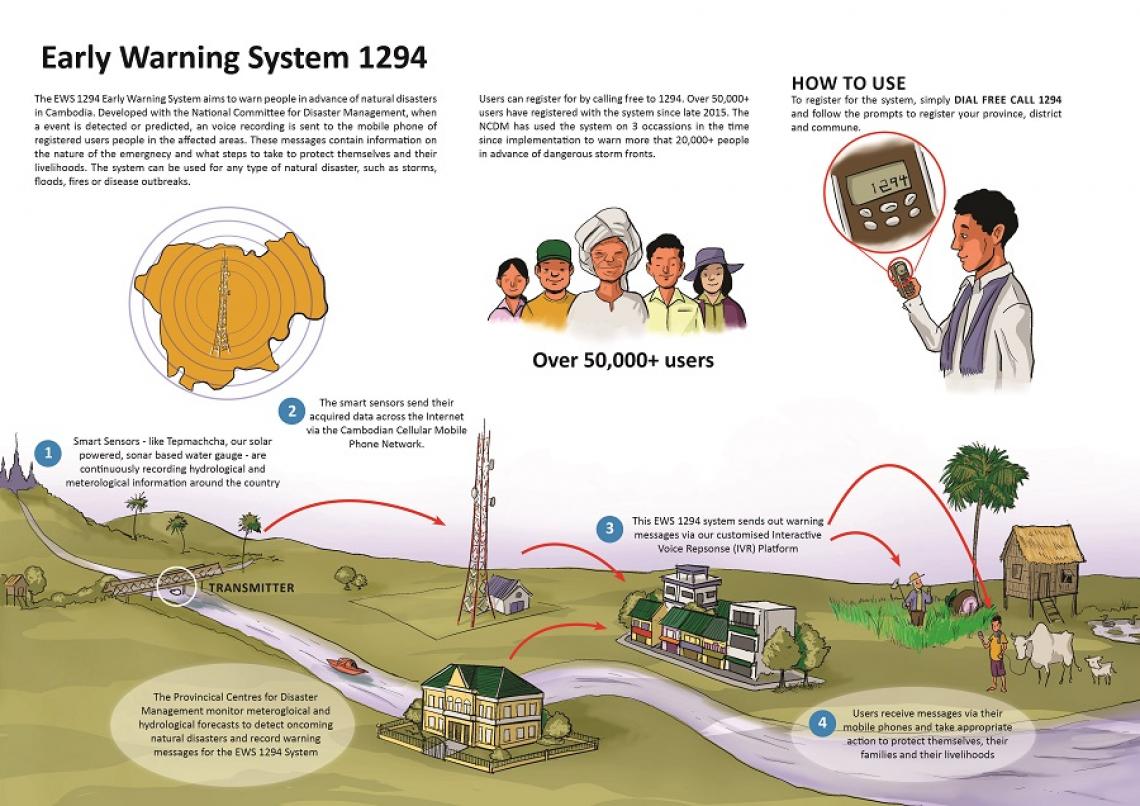
Somleng SCFM is an open source contact center platform and call flow manager designed for Somleng and Twilio. Somleng SCFM comes complete with its own REST API for managing contacts, callouts and phone calls and can be configured to send out alerts and listen for inbound calls through Somleng which provides an open source implementation of Twilio's REST API.
Unlike Twilio, Somleng gives you full control over where and how inbound and outbound calls are routed from/to. Somleng is configured to send out alerts and listen for inbound calls via SIP connections provided by the local mobile network operators.
To summarize the technology:

In Somalia, UNICEF needed to arrange an emergency cash-based transfer assistance package to help vulnerable households in Bay and Bakool during a recent drought period. In order to share information and get feedback about the program, the preferred communication method was Programmable Voice (also known as IVR). This technology allows voice messages to be recorded in local dialects and delivered to the household head by an ordinary mobile phone call, thereby allowing both illiterate and non-smartphone beneficiaries to access the service.
For this program, UNICEF placed to calls to 13,913 beneficiaries totaling 43,724 call minutes. The only other CPaaS provider other than Somleng able to provide this service was Twilio. Twilio's pricing to Somalia is $0.7680 per minute which equates to a cost of $33,580.
In addition to the prohibitively high cost, initial tests showed that the call quality through Twilio was poor due to Twilio not having any local telecom partners in Somalia so calls were initiated internationally. Furthermore, all money spent by UNICEF on this service would essentially go back to Twilio and not contribute to Somalia's economy.
Through UNICEF's existing connections, Somleng partnered with a local Somali telecom company (Hormuud Telecom) to provide network connectivity to Somali mobile subscribers. Hormuud was able to offer their network for only $0.04 per minute. Compared to Twilio's pricing ($0.7680 per minute) this is a 95% price reduction. Somleng then provided the Programmable Voice APIs to UNICEF necessary to deliver voice messages to 13,913 beneficiaries.
As a result, UNICEF was able to save $31,831 (95%) in programmable voice costs. Call quality was also dramatically improved as calls originated through a local MNO as opposed to internationally. Furthermore Hormuud Telecom was able to generate revenue through this solution contributing to the local economy of Somalia.

In Guatemala, 5 out of 10 children under six years old suffer from chronic child malnutrition. Early childhood, is the greatest window of opportunity to support the development of children's brains, bodies, and abilities through comprehensive interventions. Additionally, Guatemala is a multicultural and multilingual country, with 22 languages, including the Mayan, Spanish, Xinka and Garifuna. The use of the Spanish language has predominated in healthcare services, making it difficult for Mayan speaking population throughout the country to access public services every day.
With the objective of improving the nutritional conditions of children, adolescents, pregnant and lactating women, UNICEF Guatemala is coordinating with Government institutions at national, departmental and municipal level the implementation of comprehensive strategy to address stunting in Huehuetenango, Quiché, Chiquimula and Alta Verapaz.
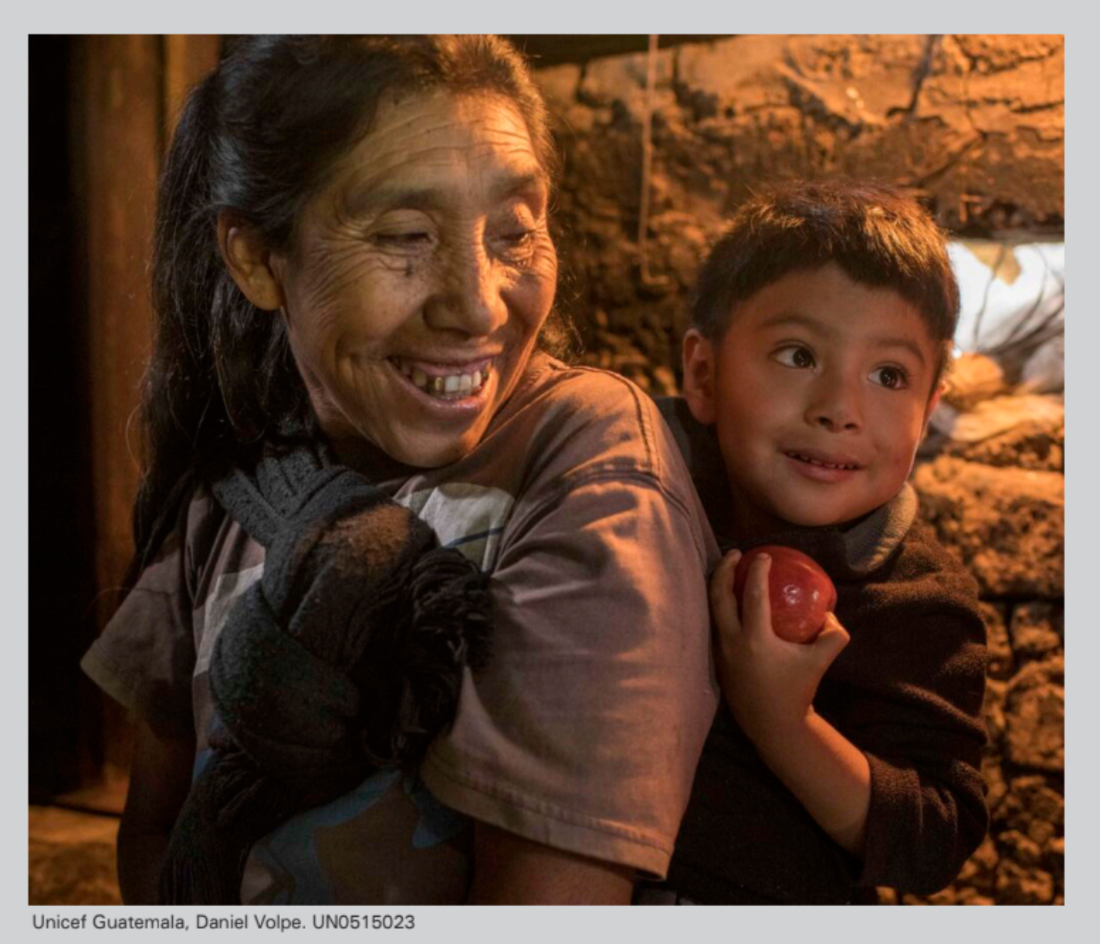
Given the current situation of COVID-19, there are actions that must be adapted to the new scenario, including the use of innovative solutions to reach the population through virtual platforms. The use mobile technology as a catalyst tool can accelerate the achievement of nutritional results for Guatemalan children.
Corazón contento is a free-volunteer subscription mobile service that seeks to promote and strength early childhood development through a comprehensive intervention, with flexible models that take into account cultural differences and the reality of the country. Using text messages (SMS), social media, as well as voice messages (IVR) to provide an integrated package of information about: health, hygiene, sanitation, maternal nutrition, breastfeeding, complementary feeding and parenting guidelines directed delivered to caregivers (mothers, fathers) of children, as well as pregnant and lactating women and primary health care workers in seven native languages (Qʼeqchiʼ, Poqomchiʼ, Chʼortiʼ, Qʼanjobʼal, Chuj, Akateko and Ixil).
To this day, UNICEF Guatemala has achieved:
RapidPro is an open source software platform that allows for building and scaling mobile-based applications from anywhere in the world. RapidPro is designed to send personalized messages with responses analyzed in real-time.
Somleng is an open source cloud communications platform which can be used to deliver IVR messages through local mobile network operators.
Voice Messages are recorded into RapidPro and delivered to the beneficiary's phone via Somleng. Together RapidPro and Somleng are powering the way governments and development partners connect, engage and collaborate directly with the most important - and often most marginalized - voices in their communities.

In Mexico, Somleng is powering C3ntro Telecom's Cloud Communications Platform as a Service (CPaaS).
Somleng provides an open source, white-labeled, CPaaS solution for all types of carriers e.g. telecom companies, mobile network operators and aggregators.
C3ntro Telecom uses Somleng to provide their own custom branded CPaaS solution to their customers. Their customers can enjoy the power of programmable voice and SMS through Somleng's open source implementation of Twilio's REST API, while C3ntro keeps their branding.
By partnering with Somleng, C3ntro can offer a full-stack solution to their customers and therefore compete directly with the big tech providers such as Twilio and Vonage.
With feedback from C3ntro we have developed Somleng with an offering for Carriers, which includes a Carrier Dashboard and API.
For more info please checkout our Carrier Documentation .
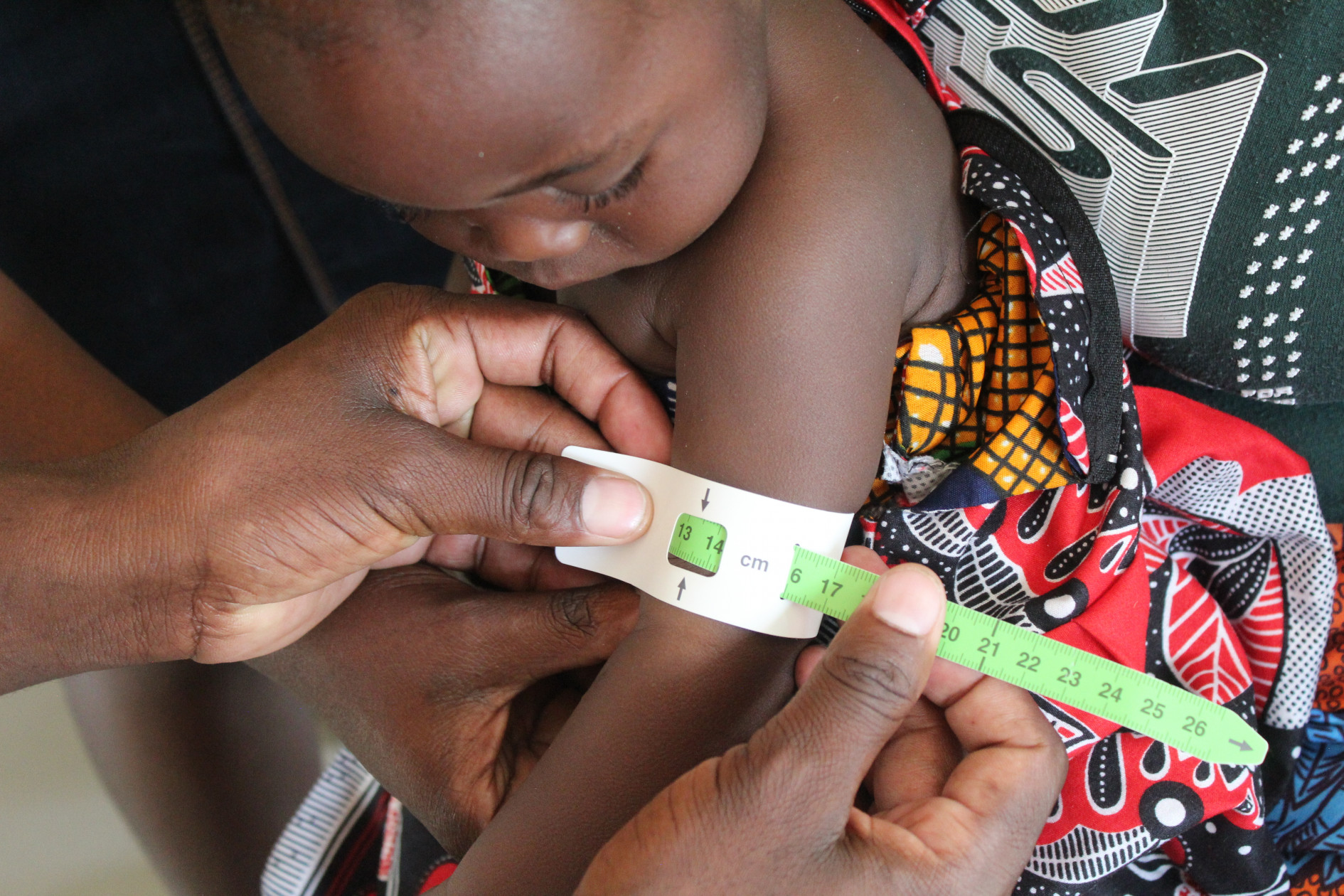 Emergency Preparedness & Response, People in Need Zambia
Emergency Preparedness & Response, People in Need Zambia
People in Need (PIN)'s mHealth project, implemented in cooperation with the Ministry of Health (MoH) Zambia Telecommunications Company Limited (ZAMTEL) and powered by Somleng, is an innovative and one-of-a-kind intervention in Zambia.
The project uses voice recorded messages to overcome illiteracy barriers and to improve maternal and child health and nutrition outcomes, influence attitudes and enhance knowledge and skills of women about the importance of key health and nutrition behaviors. The messages were incorporated into dialogues performed by a local drama group that created culturally appropriate characters to provide an educative, engaging and entertaining service, effective at changing people's behaviors. These dialogues were designed typically around specific topics such as health, nutrition or hygiene. The set contains key messages related to maternal health and nutrition as well as nutrition and health of children aged 0-6 and 7-24 months.
The messages were designed to cover the most important behaviors in order to provide timely information that supports the mother to provide the best possible start to their child's life during the first 1000 days most critical days (from the inception until the child is 2 years old). The pilot project targeted 100 women in Mongu and Nalolo districts in Western Zambia and aimed to prove that the concept is relevant and effective in the Zambian context.
The study found that the mHealth intervention has had a significant impact on knowledge, attitudes and practices of women with regards to maternal and infant nutrition and health. The level of satisfaction suggests that the service fills an important gap, is effective at changing behaviors and is highly relevant in the Zambian context. The results suggest that the intervention contributed to improved maternal and child health outcomes and led to changes in key nutrition behaviors. With several upgrades and improvements, which are currently underway, the project indicators may improve further.
More info about the Mama Info health service can be found on their website https://www.mamainfo.org .
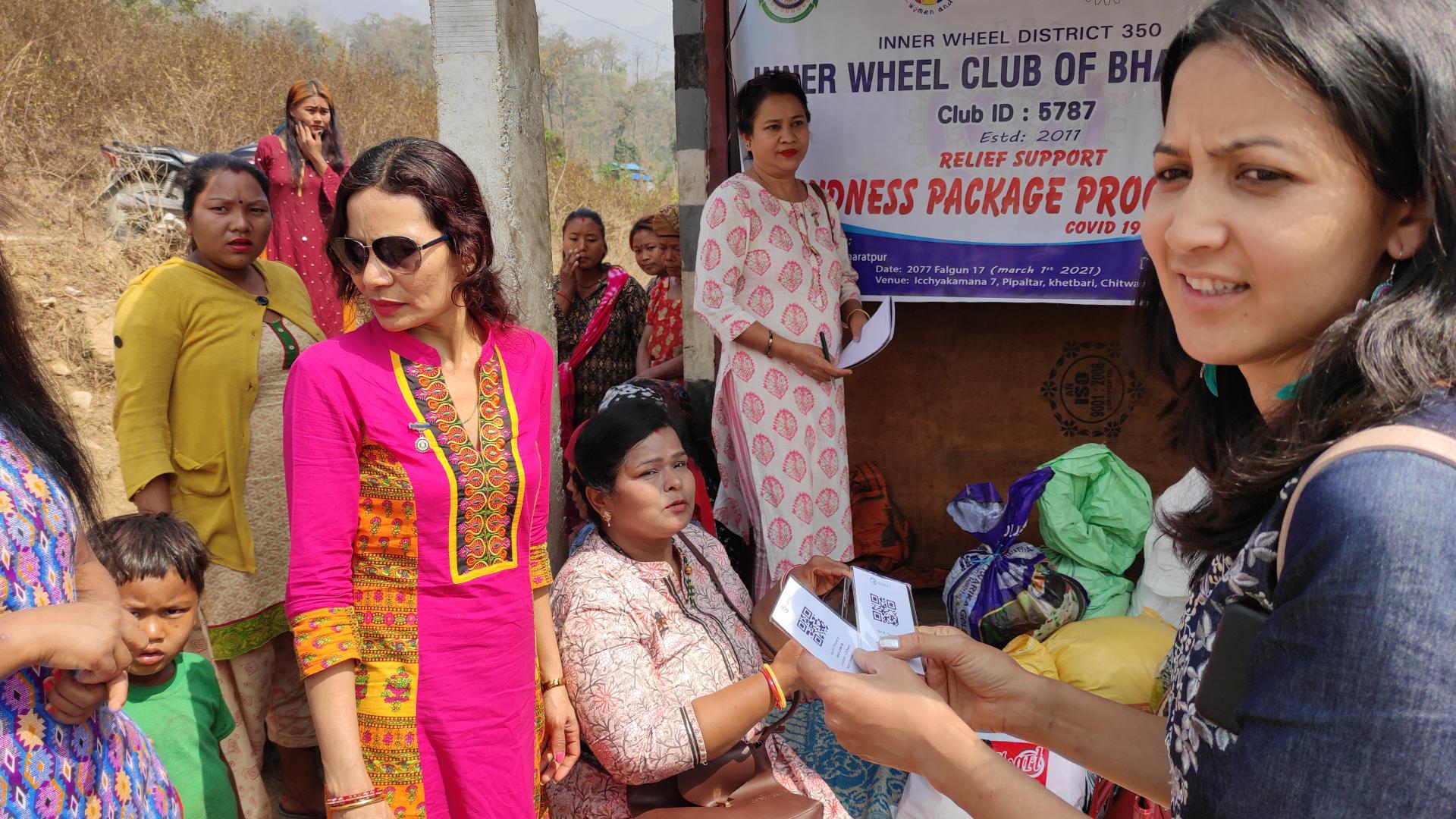 Tokenized aid distribution platform to support vulnerable communities,
Nepal
Tokenized aid distribution platform to support vulnerable communities,
Nepal
In January 2023, UNICEF Nepal launched a blockchain pilot to support 1,500 vulnerable households with cash distribution in the Madhesh province, Nepal . The cash distribution supports landless families, daily wagers and families with disabilities, with children under the age of five. The pilot uses an open-source blockchain based solution called, Rehat - developed by Rumsan , a UNICEF Venture Fund company, from Nepal.

This pilot sees a collaboration of two UNICEF Venture Fund portfolio companies, Rumsan and Somleng . Rahat is using Somleng's Carrier Bypass IVR feature . to support beneficiaries in the cash distribution pilot with information and later to receive feedback from the beneficiaries directly. This feature was developed by Somleng as part of the 2022 Growth Funding round by the UNICEF innovation fund.
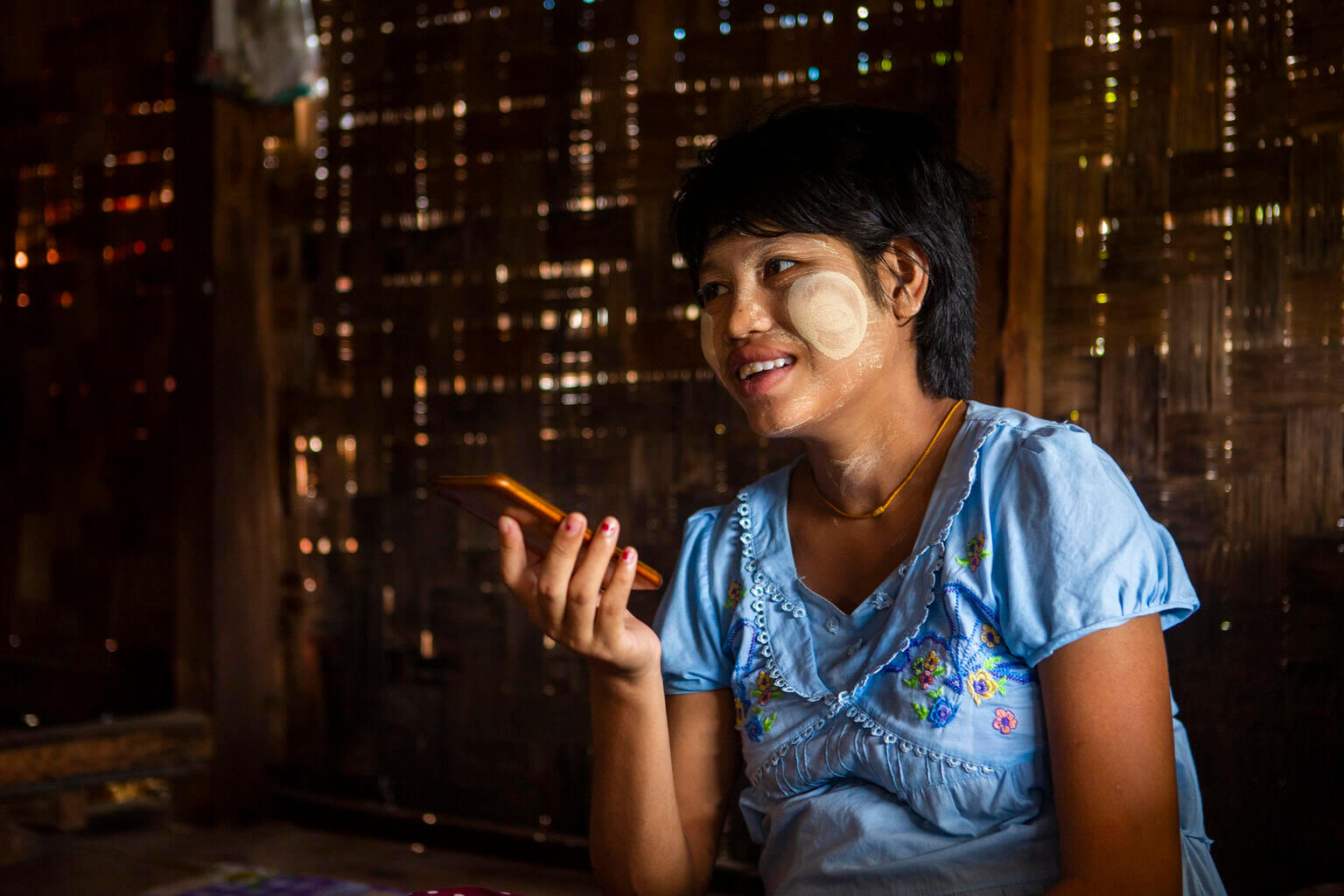 Credit: @UNICEF/UN0645246/Htet
Credit: @UNICEF/UN0645246/Htet
ParentingTips is a chatbot designed by UNICEF Cambodia with the support of the Ministry of Health and Ministry of Women Affairs to help parents and caregivers provide optimal parenting for their children.
In order to reach the maximum number of beneficiaries possible, the chatbot is implemented via Interactive Voice Response (IVR) technology . Beneficiaries interact with the chatbot by listening and responding to voice prompts which are recorded in local languages and delivered via an ordinary phone call. IVR technology overcomes barriers to entry such as the need to be literate, have Internet access or access to a smartphone.
In order to make it as simple as possible for UNICEF to improve the chatbot based on beneficiary
feedback,
RapidPro
is used as the chatbot design tool. RapidPro provides an intuitive interface for
non-technical users to design and modify chatbot flows. Flows can be designed via an easy to use
drag-and-drop interface. The completed flow is then connected to the Somleng channel which is
supported out of the box by RapidPro.
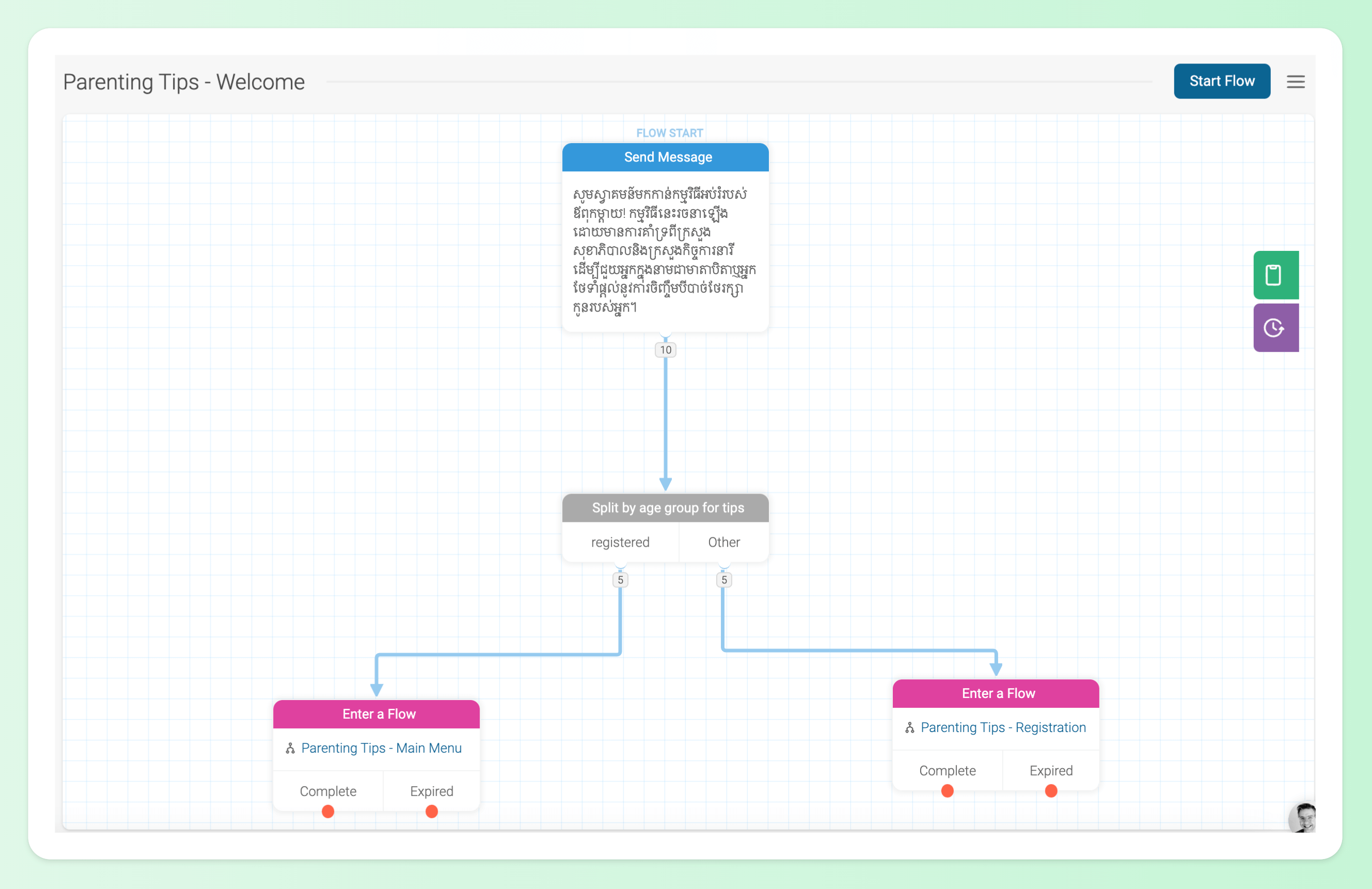 Figure 1: ParentingTips Welcome Flow
Figure 1: ParentingTips Welcome Flow
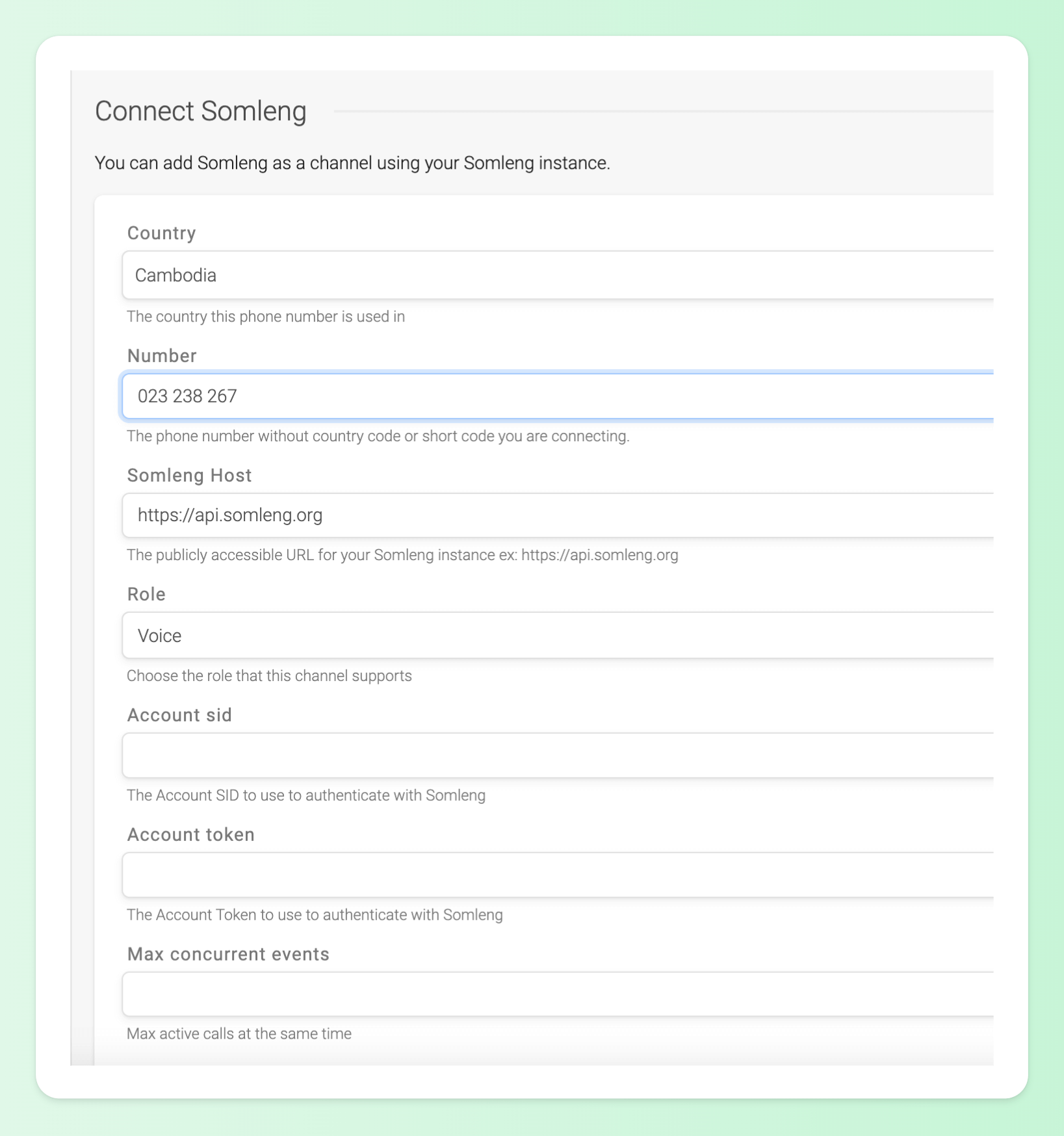 Figure 2: Somleng Channel Configuration
Figure 2: Somleng Channel Configuration
Beneficiaries opt-in to the chatbot by simply calling the short-code 1279 and following the IVR prompts configured in the RapidPro flow. The audio prompts collect beneficiary data such as: gender, child's age group, and preferred topic via a series of menus which are saved in RapidPro for later use.
For example the menu for collecting the beneficiary’s child age group is as follows (recorded in Khmer ).
Please choose an age group for your child. (សូមជ្រើសរើសក្រុមអាយុមួយសម្រាប់កូនរបស់អ្នក។)
- If you are pregnant, please press 1. (បើកំពុងមានផ្ទៃពោះ សូមចុចលេខ១។)
- If your baby is under 2 years old, press 2. (បើមានទារកអាយុក្រោម២ឆ្នាំ សូមចុចលេខ២។)
- If your child is between 3 and 5 years old, press 3. (បើកុមារតូចអាយុចន្លោះពី៣ដល់៥ឆ្នាំ សូមចុចលេខ៣។)
Below is a technical explanation of what happens during beneficiary registration.
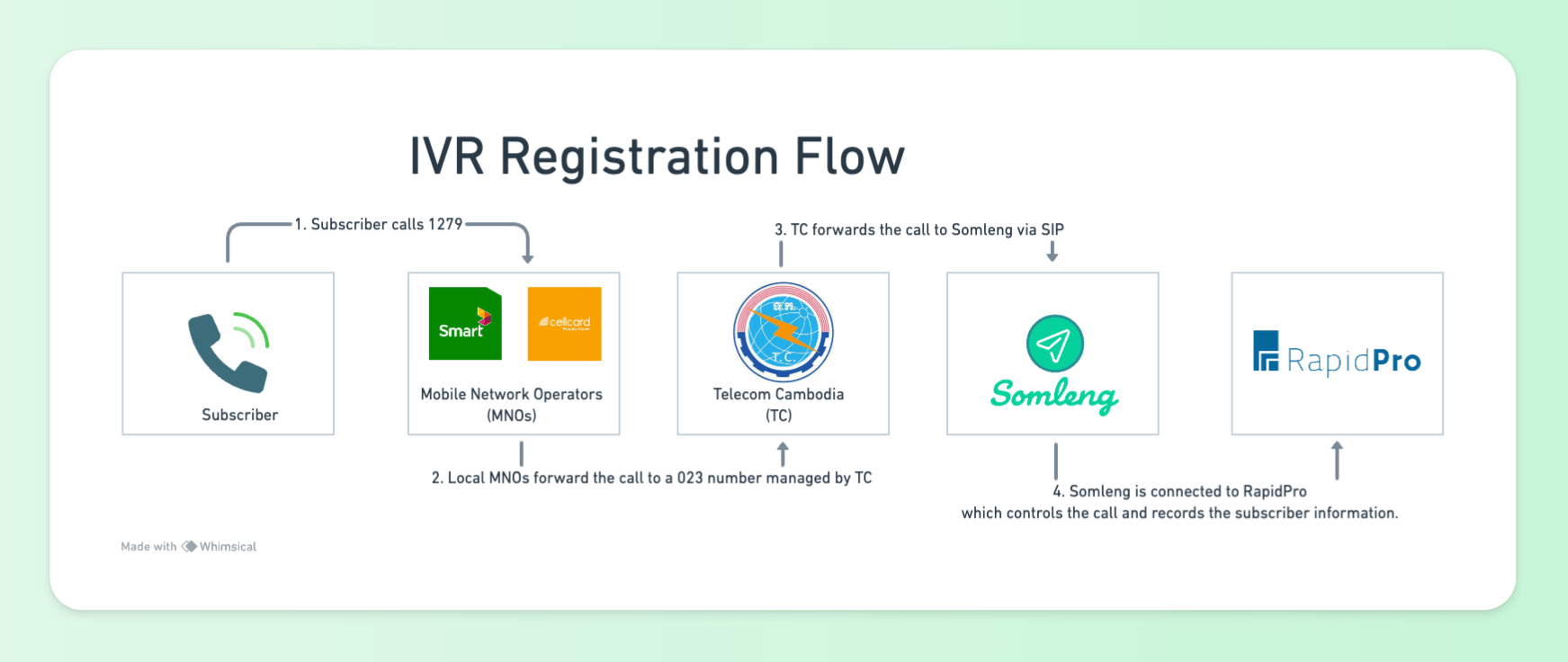 Figure 3: ParentingTips IVR Registration Flow
Figure 3: ParentingTips IVR Registration Flow
After the beneficiary is registered, the chatbot can be configured to generate periodic reminders. In order to keep the beneficiary engaged, these reminders are designed to be interactive. Configured on a rolling schedule (e.g. Weekly), the chatbot will generate an automated phone call to the beneficiary. The beneficiary picks up the phone, listens to the interactive IVR, chooses a topic of interest and listens to the message. They can choose to stay on the call as long as they want and choose different topics. When they are done, they simply hang up the call.
Here's an example of a Chatbot initiated interaction (recorded in Khmer).
Welcome to Parenting tips! Parenting tips is a chatbot designed with the support of the Ministry of Health and Ministry of Women Affairs to help you as a parent or caregiver provide optimal parenting for your child. Please choose a topic below: (សូមស្វាគមន៍មកកាន់កម្មវិធីគន្លឺះនៃការចិញ្ចឹមកូន! កម្មវិធីនេះបង្កើតឡើងដោយមានការសម្របសម្រួលពី ក្រសួងកិច្ចការនារី និងគណៈកម្មាធិការអប៉រំ និងអភិវឌ្ឈន៌កុមារតូច ដើម្បីជួយឪពុកម្តាយ ឬអាណាព្យាបាលពីរបៀបនៃការចិញ្ចឹមកូនអោយបានល្អប្រសើរ។ សូមជ្រើសរើសប្រធានបទខាងក្រោម៖)
- For Maternal Health during Pregnancy please press 1. (សូមចុចលេខ១ សម្រាប់ប្រធានបទសុខភាពមាតាក្នុងអំឡុងពេលមានផ្ទៃពោះ។)
- For maternal and newborn health up to 6 months please press 2. (ចុចលេខ២ សម្រាប់ប្រធានបទសុខភាពមាតានិងទារកទើបកើតដល់អាយុ៦ខែ។)
- For Maternal and Child Health from 6 months to 2 years old please press 3. (ចុចលេខ៣ សម្រាប់ប្រធានបទសុខភាពមាតានិងកុមារអាយុ៦ខែដល់២ឆ្នាំ។)
Below is a technical explanation of what happens during beneficiary registration.
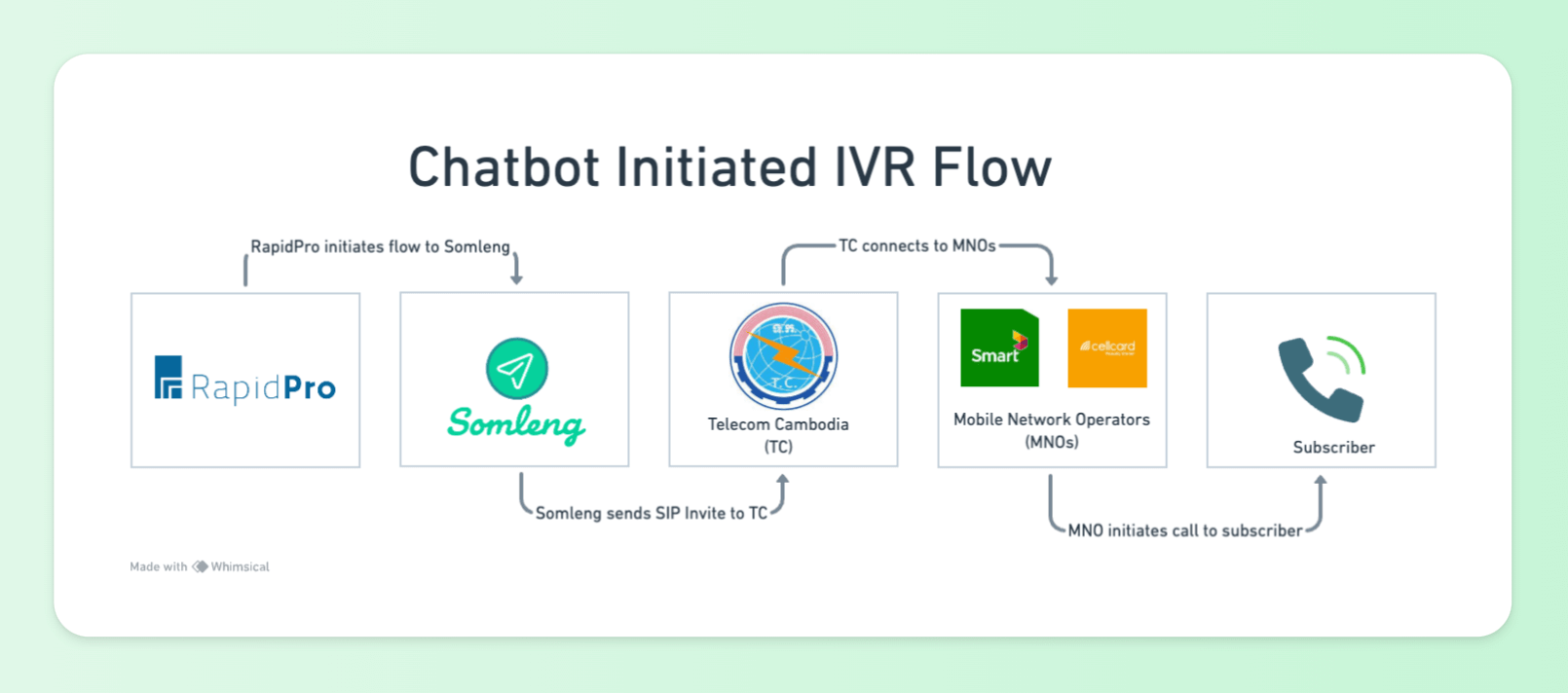 Figure 4: Chatbot Initiated IVR Flow
Figure 4: Chatbot Initiated IVR Flow
One of the biggest challenges in replicating this kind of program in another country or region is negotiating directly with the local Mobile Network Operators. This can be a challenge for many reasons. For example, it can be difficult to get a commercial agreement with a Mobile Network Operator and often there are multiple Mobile Network Operators in a given country or region.
In order to overcome these issues, Somleng has developed a Carrier Bypass feature . This feature allows entities such as UNICEF to completely bypass negotiating with local Mobile Network Operators, which can increase the speed of deploying a program like ParentingTips by an order of magnitude.
The Carrier Bypass feature works by replacing the Mobile Network Operators with an off-the-shelf
VoIP gateway
such as the one pictured below.

The VoIP Gateway is connected to Somleng and loaded with local SIM cards, replacing the role of the Mobile Network Operators. For more information on this feature please refer to the Client Gateway Configuration Guide in our documentation.